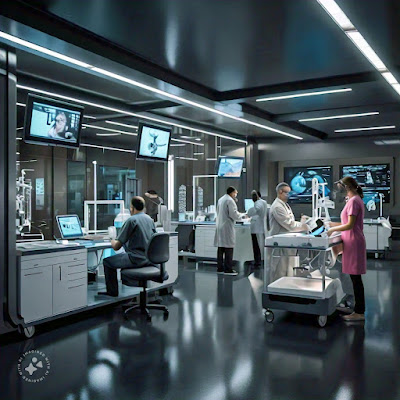Innovations in Health Care. Advances in Medical Technology
 |
Thanks to ground-breaking innovations that are transforming patient care and improving outcomes globally, the healthcare industry is changing rapidly. Technologies such as wearable health devices in diagnostics, telemedicine, and artificial intelligence (AI) are leading this transformation by providing fresh approaches to solving long-standing problems in both the US and Europe. This article explores these developments, examines how the technology is being adopted in various healthcare systems, and projects where healthcare technology will be in the future.
Modern medical technology
AI for diagnosis
Artificial intelligence is changing the field of diagnostics by improving the efficiency and accuracy of clinical diagnostics. Large data sets can be analyzed by AI systems to find patterns and generate predictions that humans might ignore. As an example, in radiology, the time required for diagnosis can be greatly reduced by using AI techniques to help identify abnormalities in imaging investigations. Research has shown that artificial intelligence (AI) can match or even exceed the diagnostic accuracy of expert radiologists, enabling earlier intervention and better patient outcomes.
Telemedicine
As a result of the pandemic, telemedicine became increasingly popular and is now an integral part of contemporary healthcare delivery. Patients can receive medical advice and treatment virtually, negating the need for in-person visits. This is especially beneficial for those who live in rural areas or have mobility issues. Telemedicine has demonstrated efficacy in chronic disease management, prompt follow-ups, and reduced hospital admissions, all of which contribute to increased patient satisfaction and participation.
Wearable medical devices
Fitness trackers and smartwatches are two examples of wearable health technology that have grown in popularity as tools for tracking one's health. By monitoring vital signs, physical activity, sleep habits and other factors, these gadgets empower users to take control of their health. The data generated by these gadgets can help healthcare professionals make more educated decisions and create more individualized treatment strategies. Wearables can alert healthcare professionals and individuals of potential health problems before they worsen.
Improving patient care and outcomes
The way in which patient care has improved as a result of incorporating these technologies is remarkable. AI in diagnostics helps prioritize cases according to urgency, which ensures that patients receive timely treatment, besides speeding up diagnosis of problems. Telemedicine improves access to care by enabling patients to contact professionals from anywhere. This is particularly important for mental health services, as stigma and access can be major barriers. By encouraging proactive healthcare and a culture of prevention rather than reaction, wearable technology empowers patients.
A comparative examination of health care systems
Because of disparities in infrastructure, finances, and regulations, American and European health care systems adopt these technologies differently.
The US healthcare system, largely privatized due to market competition, has rapidly adopted the technology. Many healthcare providers now offer telemedicine as part of their offerings, and AI is being used more and more in many specialties. Regulatory hurdles and data privacy concerns, for example, remain major obstacles.
On the other hand, with their publicly supported health care systems, many European countries favor fair access over rapid technological adoption. While AI and telemedicine are becoming more and more popular, adoption of these technologies may take longer because they need to be thoroughly evaluated and integrated into existing systems. However, nations such as Sweden and Denmark are recognized for effective deployment of telehealth services, demonstrating that the approach can produce favorable outcomes.
The future of healthcare technology
The future prospects of healthcare technology are very bright. Upcoming innovations include blockchain for secure health data management, augmented reality for surgical training, and genomic medicine. These advances may further improve operational effectiveness and patient outcomes.
Still, many challenges remain. Data capture and security are full enterprises, especially as more health information is collected and shared. In addition, the digital age may compound inequities in access to health care, particularly among underserved populations. The regulatory fabric will need to evolve to keep pace with technological advances while maintaining patient safety and data protection.
The result
Healthcare innovations aren't just reshaping how care is delivered. They are unnaturally changing the patient experience and problems. As AI, telemedicine, and wearables continue to evolve, their impact will only grow. A collaborative approach that embraces technology while addressing ethical, non-supervisory and availability issues will be critical to understanding the full context of these developments. The future of healthcare technology holds great promise, and by navigating the challenges that come with it, we can create a more efficient, impartial, and case-centered healthcare system.



Post a Comment